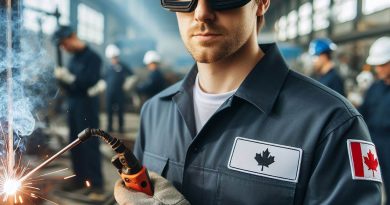Health and Safety for Mechanics in Canada
Last Updated on December 30, 2023
Introduction
The well-being of employees should be a top priority for all workplaces. Health and safety regulations play a crucial role in ensuring a safe environment for workers.
In Canada, the significance of health and safety in various industries cannot be overstated, especially for mechanics.
Mechanics perform tasks that expose them to potential health risks, such as exposure to hazardous chemicals, loud noises, and physical strain.
It is essential for mechanics to adhere to safety protocols to prevent accidents, injuries, and long-term health issues.
This blog post aims to raise awareness among mechanics in Canada regarding the importance of prioritizing health and safety.
By following proper safety procedures, mechanics can safeguard their well-being and maintain a productive work environment.
Furthermore, this post will provide practical tips and guidelines to help mechanics identify and address potential health and safety hazards in their daily work.
Additionally, it will emphasize the legal obligations of employers in ensuring a safe working environment for mechanics.
By promoting health and safety practices, we can enhance the overall well-being and job satisfaction of mechanics in Canada.
It is our responsibility to prioritize the safety of all workers and create a culture that values and promotes health and safety in the workplace.
Stay tuned for the upcoming sections of this blog post, where we will explore different aspects of health and safety for mechanics in further detail.
Overview of the Canadian mechanics industry
Statistics and growth of the industry in Canada
The mechanics industry in Canada has been growing steadily over the years, contributing significantly to the country’s economy.
According to statistics, there are approximately 213,000 mechanics employed in Canada, with an average annual growth rate of 1.5%.
The industry has seen a rise in demand due to the increasing number of vehicles on the road and advancements in automotive technology.
With a strong focus on automobile manufacturing, the mechanics industry is projected to continue its growth trajectory in the coming years.
Common work environments for mechanics
Mechanics in Canada work in diverse environments, ranging from automotive repair shops, dealerships, to manufacturing plants.
Automotive repair shops are the most common work environment for mechanics, offering services to individual vehicle owners.
Dealerships provide mechanics with opportunities to work on different vehicle brands and models.
Some mechanics are employed by manufacturing plants where they assemble and test new vehicles.
Regardless of the work environment, mechanics face similar health and safety challenges that need to be addressed.
Potential hazards and risks
Mechanics in Canada are exposed to various hazards and risks that can adversely affect their health and safety.
Exposure to harmful chemicals such as gasoline, solvents, and cleaning agents poses a significant risk to mechanics.
Working in confined spaces, such as under vehicles or in engine compartments, increases the risk of injuries and accidents.
Excessive noise levels in some work environments can lead to hearing damage if proper protective measures are not taken.
Mechanics also face the risk of ergonomic injuries due to repetitive movements and awkward body postures during repairs.
Another hazard is the potential for injuries from tools and equipment, such as cuts, burns, or getting hit by flying objects.
To mitigate these risks, it is crucial for mechanics and employers to prioritize health and safety measures.
In short, the Canadian mechanics industry has experienced steady growth and contributes significantly to the overall economy.
Mechanics work in a variety of environments, each with its own unique challenges and risks.
From exposure to hazardous chemicals to working in confined spaces, mechanics face several health and safety hazards.
It is essential for both mechanics and employers to prioritize health and safety measures to ensure a safe working environment.
Read: Interviews with Top Canadian Mechanics
Legislation and regulations for mechanics’ health and safety in Canada
Introduction to Occupational Health and Safety (OHS) laws
- The OHS laws in Canada aim to protect workers’ health and safety in their workplaces.
- These laws apply to all industries, including the automotive sector where mechanics work.
- OHS laws are designed to prevent workplace accidents, injuries, and occupational diseases.
- Mechanics are subjected to specific regulations to ensure their health and safety at work.
Role of Canadian Centre for Occupational Health and Safety (CCOHS)
- The CCOHS is an authoritative source of information on OHS for both employers and employees.
- Its role is to ensure safe and healthy working conditions through education and training programs.
- CCOHS provides guidance on OHS legislation, standards, and best practices for mechanics.
- Mechanics can access CCOHS resources to enhance their knowledge and protect themselves at work.
Key regulations specifically for mechanics
Personal Protective Equipment (PPE) Regulations
- Mechanics must wear appropriate PPE, such as safety goggles, gloves, and steel-toed boots.
- PPE should be provided by employers and used in accordance with manufacturer instructions.
- Regular inspections and maintenance of PPE should be conducted to ensure effectiveness.
Hazardous Substances Regulations
- Mechanics are often exposed to hazardous substances like chemicals, solvents, and asbestos.
- Employers must assess and control exposure to prevent health issues related to these substances.
- Proper storage, handling, and disposal procedures should be followed to minimize risks.
Control of Substances Hazardous to Health (COSHH) Regulations
- COSHH regulates the use and control of hazardous substances in the workplace.
- Mechanics must be trained to identify, assess, and control hazards associated with chemicals.
- Employers are responsible for providing necessary training, information, and protective measures.
Work Equipment Regulations
- Employers must ensure that all machinery and equipment used by mechanics is safe and well-maintained.
- Regular inspections, maintenance, and repairs are essential to prevent accidents and injuries.
- Mechanics should receive proper training on machine operation and safety procedures.
Occupational Exposure Limits (OEL) Regulations
- OEL limits the amount of hazardous substances that mechanics can be exposed to.
- Employers should monitor and assess occupational exposure levels to protect mechanics’ health.
- If exposure surpasses OEL, employers must take corrective actions to reduce risks.
Overall, mechanics in Canada are protected by various legislation and regulations to ensure their health and safety at work.
Understanding and adhering to these regulations is crucial for both employers and mechanics to create a safe working environment.
Organizations like the CCOHS provide valuable resources to assist mechanics in complying with OHS laws and enhancing their knowledge on health and safety practices.
Read: Canadian Mechanic Jobs: Trends and Forecasts
Main Health and Safety Concerns for Mechanics in Canada
Hazardous Materials and Waste Management
- Mechanics in Canada must be aware of the hazards posed by handling and disposing of hazardous materials.
- They should receive proper training on identifying, handling, and storing hazardous materials.
- Mechanics should follow the regulations and guidelines set by the Canadian government for waste management.
- It is crucial to use appropriate personal protective equipment (PPE) when working with hazardous materials or waste.
- Mechanics should ensure that hazardous materials are stored in designated areas and properly labeled.
- Regular inspections and maintenance of storage areas are necessary to prevent leaks or spills.
Fire Safety Precautions and Procedures
- Mechanics need to be aware of potential fire hazards in their workplace and take necessary precautions.
- They should ensure that fire extinguishers are readily available and regularly inspected and maintained.
- It is important to have a well-defined fire emergency plan, including evacuation routes and assembly points.
- Mechanics should receive proper fire safety training, including the use of fire extinguishers.
- Regular fire drills should be conducted to ensure all employees are familiar with the emergency procedures.
Proper Use of Personal Protective Equipment (PPE)
- Mechanics must wear appropriate PPE to protect themselves from potential hazards in their work environment.
- PPE includes items such as gloves, safety glasses, protective clothing, and respiratory protection.
- Proper training should be provided on how to select, wear, and maintain PPE correctly.
- Mechanics should regularly inspect their PPE for any signs of damage or wear and replace them if necessary.
- Using PPE correctly can minimize the risk of injuries, illnesses, and exposure to hazardous substances.
Injury Prevention Techniques and Ergonomic Considerations
- Mechanics should use proper lifting techniques to avoid strains and musculoskeletal injuries.
- Regular breaks and stretching exercises can help prevent fatigue and reduce the risk of repetitive strain injuries.
- Proper ergonomics, such as having adjustable workstations and tools, can improve comfort and reduce injuries.
- Mechanics should follow safe work practices and avoid rushing or taking shortcuts that may lead to accidents.
- Employers should provide training on injury prevention techniques and promote a culture of safety in the workplace.
Importance of Proper Tool Maintenance and Inspection
- Regular maintenance and inspection of tools are crucial to ensure their safe and efficient operation.
- Mechanics should follow manufacturer guidelines for tool maintenance and keep records of inspections.
- Faulty or damaged tools should be promptly taken out of service and reported to the appropriate personnel.
- Using damaged or improperly maintained tools can lead to accidents, injuries, and damage to equipment.
- Mechanics should also ensure that tools are properly stored and organized to prevent injuries and damage.
In essence, mechanics in Canada face various health and safety concerns.
It is important for them to have proper knowledge, training, and equipment to effectively address these concerns and maintain a safe work environment.
Read: Mobile Mechanics: A Growing Trend in Canada

Training and certification requirements for mechanics in Canada
Being a mechanic in Canada requires specific training and certification to ensure the health and safety of workers.
Mandatory training programs
- Mechanics in Canada must complete mandatory training programs to obtain certification.
- These programs cover various areas such as automotive systems, electrical diagnostics, and workplace safety.
- Training programs focus on developing technical skills and knowledge necessary for the profession.
- Completion of these programs is a prerequisite for obtaining a mechanic’s license in Canada.
Benefits of continuing education and professional development
- Continuing education allows mechanics to stay updated with the latest automotive technologies and repair techniques.
- Professional development programs enhance their skills and enable them to provide better services to customers.
- Mechanics can specialize in specific areas through further training, such as hybrid vehicle maintenance or advanced diagnostics.
- Continuing education and professional development also enhance job prospects and career advancement opportunities.
Safety awareness programs for mechanics
- Safety awareness programs educate mechanics about potential hazards in their work environment.
- These programs provide knowledge on the safe use of tools, equipment, and handling of hazardous materials.
- Mechanics learn about proper ventilation, fire safety, and the importance of personal protective equipment (PPE).
- Participation in safety awareness programs reduces the risk of workplace accidents and injuries.
Overall, training and certification requirements for mechanics in Canada play a crucial role in ensuring their competence and safety.
Mandatory training programs provide a solid foundation of knowledge and skills, enabling mechanics to perform their duties effectively.
Continuing education and professional development offer numerous benefits, including staying updated with industry advancements and improving career prospects.
Safety awareness programs further enhance mechanics’ ability to identify and mitigate workplace hazards, minimizing the risk of accidents and injuries.
It is essential for mechanics to prioritize their training and certification to promote a safe and healthy work environment.
Read: The Impact of AI on Mechanics in Canada
Best practices for promoting health and safety in the mechanic workplace
Mechanics have a demanding job that involves working with various tools, equipment, and potentially hazardous materials.
It is crucial to prioritize health and safety in the mechanic workplace to prevent accidents and ensure the well-being of all employees.
This section will discuss the best practices that can be implemented to promote health and safety in the mechanic workplace in Canada.
Regular maintenance and inspection of equipment and tools
One of the key practices to ensure a safe working environment is the regular maintenance and inspection of equipment and tools.
Mechanics rely heavily on their tools, and any malfunction or damage can pose serious risks.
By conducting regular maintenance checks and inspections, mechanics can ensure that their equipment is in proper working condition, minimizing the chances of accidents or injuries caused by faulty tools.
Establishment of clear safety protocols and policies
Another important practice is the establishment of clear safety protocols and policies.
These protocols should cover various aspects of workplace safety, such as proper handling of hazardous materials, safe operation of equipment, and guidelines for emergency situations.
Clear protocols provide mechanics with a structured framework to follow, reducing the chances of confusion or negligence that could lead to accidents.
Emphasizing effective communication and reporting of hazards
Effective communication and reporting of hazards also play a crucial role in promoting health and safety.
Mechanics should be encouraged to communicate any potential hazards they come across and report them promptly.
This allows the management to take immediate action and implement necessary preventive measures.
Open and transparent communication helps create a culture of safety where all employees actively contribute to identifying and addressing potential risks.
Encouraging a safety-oriented culture and teamwork
Creating a safety-oriented culture and promoting teamwork is vital for maintaining a safe workplace.
Mechanics should be encouraged to prioritize safety in their daily tasks and look out for one another.
By fostering a culture that values safety and teamwork, mechanics can collectively take responsibility for creating a safe and healthy work environment.
Regular safety audits and risk assessments
Regular safety audits and risk assessments are essential practices to identify potential hazards and implement preventive measures effectively.
Conducting audits allows management to evaluate the effectiveness of existing safety protocols and identify areas that need improvement.
Risk assessments help identify potential risks and develop strategies to mitigate them, ensuring a safer work environment.
In general, promoting health and safety in the mechanic workplace requires a holistic approach that includes regular maintenance of equipment, clear safety protocols, effective communication, a safety-oriented culture, and regular safety audits.
By implementing these best practices, mechanics can create a safer working environment and minimize the risk of accidents or injuries.
Prioritizing health and safety not only protects the well-being of employees but also contributes to the overall efficiency and success of the mechanic industry in Canada.
Resources and Support Available for Mechanics in Canada
Online platforms and websites with health and safety guidelines
- Canadian Centre for Occupational Health and Safety (CCOHS) provides comprehensive resources and guidelines on workplace safety specifically for mechanics.
- WorkSafeBC offers an online portal with a wide range of information and tools dedicated to mechanic safety in British Columbia.
- Occupational Safety and Health Administration (OSHA) in the United States also provides valuable resources that can be applicable to Canadian mechanics.
Associations and organizations dedicated to mechanic safety in Canada
- Automotive Industries Association (AIA) of Canada offers various programs and initiatives focusing on providing training and resources to promote mechanic safety.
- The Canadian Association of Road Safety Professionals (CARSP) works towards enhancing road safety, which indirectly supports the well-being of mechanics.
- Mechanic Safety Association of Canada aims to promote and improve safety practices specifically within the mechanical industry.
Government resources and programs for supporting health and safety initiatives
- Employment and Social Development Canada (ESDC) provides information on workplace hazards, rights and responsibilities, and guides to develop safety programs.
- The Canadian Centre for Occupational Health and Safety Act establishes safety standards and regulations to protect workers, including mechanics.
- The Workplace Safety and Insurance Board (WSIB) offers insurance coverage and support to mechanics who sustain work-related injuries or illnesses.
Having access to these resources and support is essential for the well-being of mechanics in Canada.
By utilizing online platforms and websites, mechanics can easily access guidelines and information regarding health and safety practices.
The CCOHS provides a wealth of resources specifically tailored to the needs of mechanics, ensuring they have the necessary knowledge to work safely.
In addition, WorkSafeBC offers a platform where mechanics can find resources pertinent to their province, further ensuring their safety.
Although OSHA is an American organization, their guidelines and resources can serve as a valuable reference for Canadian mechanics.
Associations such as the AIA and CARSP play a pivotal role in promoting mechanic safety through training programs and awareness campaigns.
Furthermore, the Canadian Centre for Occupational Health and Safety Act ensures the existence of regulations that safeguard mechanics.
In the unfortunate event of work-related injuries or illnesses, mechanics can rely on the support provided by WSIB.
They offer insurance coverage and services to aid mechanics in their recovery and return to work.
In a nutshell, mechanics in Canada have access to a wide range of resources and support systems dedicated to their health and safety.
These resources, including online platforms, associations, organizations, and government programs, aim to ensure that mechanics are equipped with the information and tools necessary to work safely.
Conclusion
Health and safety are paramount for mechanics in Canada.
To summarize, we have discussed the key points regarding health and safety for mechanics.
It is crucial to emphasize the significance of health and safety for mechanics in Canada.
Understanding the significance of adopting proactive measures is crucial to maintaining a secure work environment.
To recap, the importance of prioritizing health and safety cannot be overstated.
From wearing personal protective equipment to following proper procedures, mechanics must be vigilant.
Adherence to safety protocols, regular training, and maintaining well-equipped workspaces are key. It’s essential to foster a culture that places health at the forefront.
Encouraging every mechanic to prioritize their well-being ensures a thriving and secure industry.
Let’s collectively commit to a future where safety is non-negotiable in the mechanic profession.
Moving forward, we must encourage the mechanic industry to prioritize health and safety measures.


